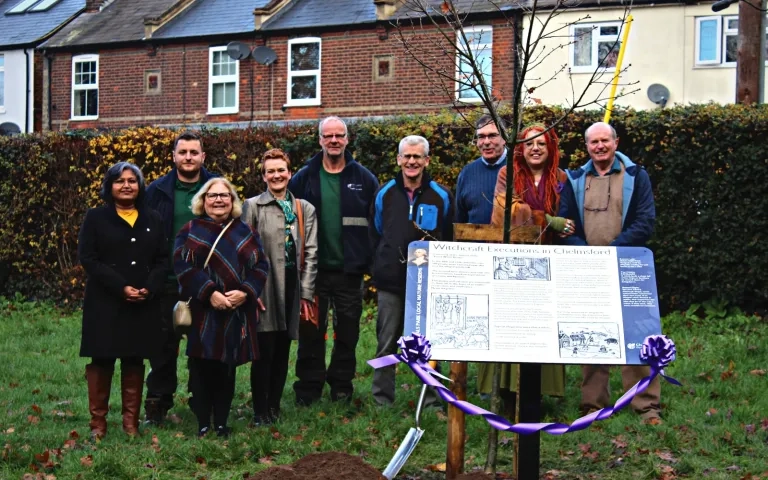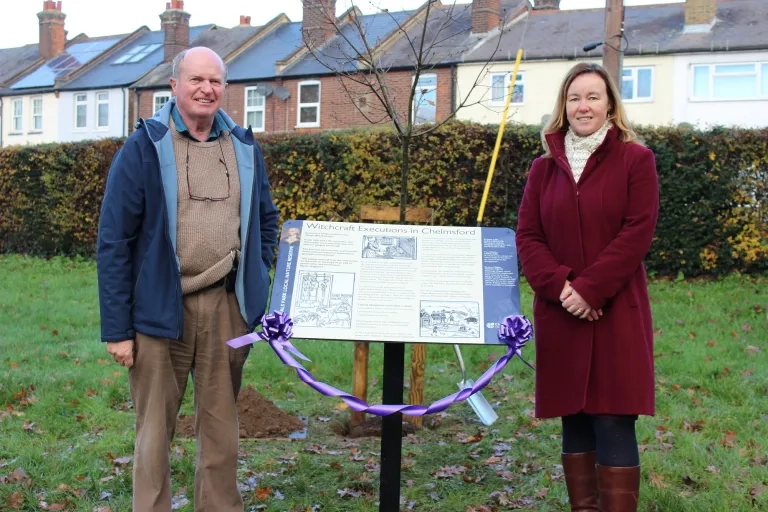Admirals Park memorial for witch trial victims

An interpretive plaque and oak tree have been installed in Admirals Park in memory of Chelmsford’s witch trial victims. More than 100 innocent people were accused of witchcraft and executed in Chelmsford during the 16th and 17th centuries.
The plaque and tree were unveiled in a dedication ceremony on Thursday 1 December. Councillor Rose Moore, Cabinet Member for Greener and Safer Chelmsford, and John Worland, local historian, gave speeches during the ceremony, touching on the importance of remembering these tragic executions.
Councillor Marie Goldman, Deputy Leader for Chelmsford City Council and Cabinet Member for Connected Chelmsford says the memorial reminds us of a shameful period in history.
“"Admirals Park is the perfect location for this memorial, being so close to the site where so many victims endured unimaginable suffering and injustices. I hope that the monument will serve as a reminder to the public of the tragedies behind this history."
Cllr Marie Goldman, Chelmsford City Council’s Deputy Leader and Cabinet Member for Connected Chelmsford

John Worland, who campaigns for greater awareness of Essex’s witchcraft persecution victims, says the victims should be honoured and remembered.
“"The victims of these witch hunts were innocent people who were persecuted as a result of ignorant and malicious superstitions. The pain and tragedy they suffered is unfathomable and should never be forgotten. It’s never too late to raise awareness of this terrible history and so I’m delighted that Chelmsford City Council have honoured witch trial victims with this memorial."
John Worland, local historian
Dangerous superstitions resulted in fear and suffering
Superstition was rife during the early modern period. Though there were some witch trials prior to the 16th century, the Witchcraft Act of 1563 (formally titled ‘Act agaynst Conjuracons Inchantments and Witchecraftes’) led to increased witch hunts across England.
Members of the public were led to believe that so-called ‘witches’ were capable of dangerous curses. They believed witches could make farmers’ livestock ill, force crop failures, cause loved ones’ unexpected deaths and many other crimes. Most witch trial victims were women. Often, they were simply disliked or not trusted and were denounced by their own neighbours and accused of sorcery.
From the early 17th century, James I enacted changes to the Witchcraft Act, which further increased fear and superstition across the country and saw even more trials taking place.
Essex’s death toll highest in England
The county of Essex was well known for witchcraft persecutions in the early modern period. The Essex courts executed more people for witchcraft crimes than any other county in England. Execution was by hanging and between just 1570 and 1609, 53 people were executed for witchcraft in Essex.
Chelmsford was particularly notable as the place of execution of many alleged witches, including Agnes Waterhouse from Hatfield Peverel. Agnes was hanged in Chelmsford on 29 July 1566, just two days after her trial took place at Tindal Square, where Shire Hall now stands.
Executions picked up pace into the 17th century and in one year alone – in 1645 – 15 women were tried and executed in Chelmsford for the crime of witchcraft. This period saw the rise of the self-appointed ‘Witchfinder General’, Matthew Hopkins, who received payments from towns for bringing witches to trial.
See the tribute at Admirals Park
You can visit the memorial at Admirals Park, which was recently declared a local nature reserve. It’s located at the eastern boundary, close to South Primrose Hill where many of the historic executions took place.





